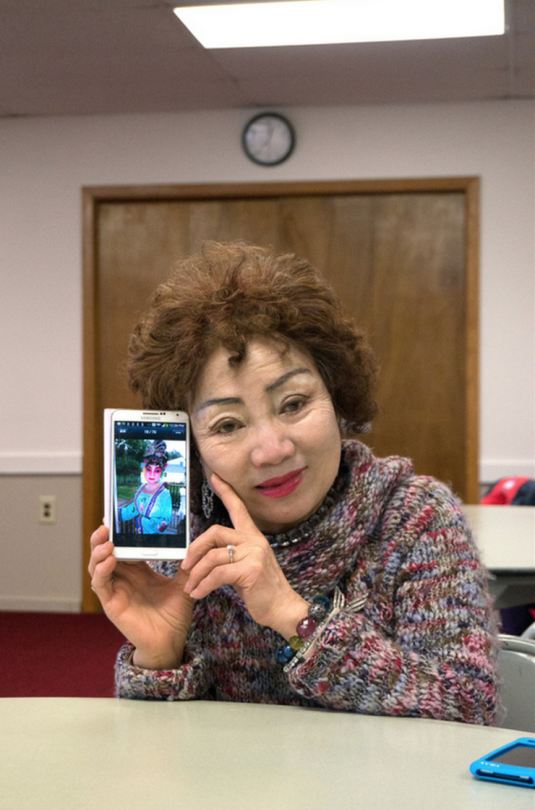
Stories of Self is a(n approximately) monthly essay series by Scott F. Parker that explores the nature of the composed self through conversations with memoirists, theorists, artists, and possibly musicians.
Just the Right Amount of Empathy with Wing Young Huie
Shooting pictures is a lot like shooting a basketball for me.
When it’s going well the ball seems to go in by itself.
—Wing Young Huie
Wing Young Huie is a photographer best known for massive installments that occur along the same streets where he takes his photographs. His pieces tend toward documentary studies of the relationship between individuals and society, and the power of the image to shape identity.
In his current project, Chinese-ness, Wing explores Chinese identity—the ways in which it is “personal, national, cultural, political”—and wonders: “Does it migrate, become malleable or transmuted? When is it authentic, sacred, exotic, kitsch?” In the I Am the Other series, Wing enters the lives of his subjects, Chinese men of his approximate age, living lives he might have lived. The resulting photographs produce a hypothetical memoir, a record of an alternate reality in which the contingencies of history have run a different course. The series is a visual-subjunctive meditation on the self. For a captured moment, Wing-as-he-is becomes Wing-as-he-might-have-been—and Wing-as-he-might-have-been comes into a kind of being. If photography invents the past, Chinese-ness gives it the chance as well to imagine—to image—other presents.
I first encountered Wing not long after moving to Minneapolis. He was shooting buckets at the Y. A year or so later, we were introduced by a mutual friend, and a few months after that I joined his church-basement pick-up game. For the next few years I played weekly with Wing and got to know him as an artist, a community-builder, and a friend—as well as a graceful player and deadly three-point shooter.
We met one morning at his gallery in south Minneapolis to talk about Chinese-ness. I’d been to The Third Place Gallery many times. Wing hosts a monthly event in which he brings in artists—filmmakers, musicians, and spoken word poets, as well as photographers—to present works in progress. Afterwards, wine is served, ping-pong is played, and karaoke is performed in the basement. I don’t know if Wing is just playing to his strengths with these choices of activities. He’s an ace ping-pong player and has mastered renditions of several songs, including Edward Sharpe and the Magnetic Zeros’ “Home” and “Your Song” from Moulin Rouge. The gallery takes its raison, as well as its name, from the work of sociologist Ray Oldenburg, who argued for the importance of a third environment away from home and work where people can gather socially for creative interactions. Wing’s Third Place is as welcoming and inclusive a space as I know and holds a valuable and beloved position in the community. The big irony is that for Wing, the Third Place is not just a third place, but his first and second places as well. This is his work, after all. And his home is close enough to allow him to cook stir fry in his kitchen and serve it around the gallery’s ping-pong table, as he’s been known to do. Wing is the kind of artist about whom it’s impossible to identify any meaningful divide between art and life.
This is no accident. The environment Wing creates is very much of a piece with the subjects of his photographs. From the beginning, his work has been deeply linked with place. Whether shooting documentary-style or posing his subjects, Wing has sought to make images of people that reflect how they see themselves and counter the ways they would usually appear in popular media—or, as is very often the case, for reasons of race and class, how they wouldn’t appear at all. He pursues an honesty at all times, but the honesty is less an objectivity than an unexpected and intelligent subjectivity. There is presumption here, as there inevitably is when privilege and power are as unbalanced as between photographer and subject. Wing presumes to be the one to give image and to do it well. Everything in his work depends on this well.
In his Lake Street USA project, Wing exhibited his photographs on bus stops and the sides of buildings along the six miles of Lake Street. By bringing the work back to the people and places of the photographs, Wing sought to deny himself the exploitative aspect of much documentary photography. His work is beholden to his subjects. But for someone concerned with the power dynamics of the photographic relationship, even this was not enough. Ten years later, when Wing did a similar project on University Avenue, he introduced a new technique that gave power back to the subject. He handed people blank chalkboards and asked them to respond to prompts such as “How do you see yourself? How do others see you?” and “What are your dreams?”
Susan Sontag has written that “the caption is the missing voice…. But even an entirely accurate caption is only one interpretation, necessarily a limiting one, of the photograph to which it is attached.” The chalkboard hands the authorship of the caption over to the subject. This is a significant amount of control for Wing to give up, and a lot of responsibility to put on the subject (who, as well as she knows herself, never really knows what the camera will reveal about her). At first glance the pictures suffer for this shift: the images can appear gimmicky or overly staged compared to more standard documentary work, a too heavy-handed emphasizing of Dorothea Lange’s observation that “the camera is an instrument that teaches people how to see without a camera.” Not only how to see, though, also what to see. A photograph is a moral as well as an aesthetic imperative. But the moral is ambiguous. The humanist support for documentary is that exposure to difference breeds compassion (and, hopefully, leads to social change), but—here’s Sontag again—“To take a picture is to have an interest in things as they are, in the status quo remaining unchanged.” It literally preserves what is.
Wing’s moral goes beyond abstract compassion. His is to break down barriers, including the barrier of the power to define. Yes, he’s interested in tipping power imbalances away from white supremacy and heteronormativity, but more fundamentally, he’s interested in tipping the power imbalances of media.
It takes time to understand the chalkboards within the larger context of Wing’s concerns before one can appreciate how artistically bold a move this is. The text on the chalkboards is not the message; the message is the medium—specifically, the self-defined agencies behind the texts. We can find Wing in these images—but his presence is less totalizing than is the photographer of most photos. A Wing Young Huie is distinctive, but what’s most distinctive about it is the room he makes for the subject. But even making all that room, look carefully and you’ll see that Wing is there in the blank chalkboards, the invisible frames, and the occasion of his own silencing.
In Projects, the photographer Nikki S. Lee presents a malleable subject. She adopts different ages and racial appearances as she embeds herself within various cultures. Without knowing the project, the viewer wouldn’t recognize the punk as the schoolgirl as the swinger, and so on. In a way Lee is a forerunner to Wing’s Chinese-ness. In another way, Projects occludes the central intrigues of the investigation of identity. In his essay “What Is it like to Be a Bat?” Thomas Nagel, examining the qualities of subjective experience, argues that there is something it is like to be a conscious thing and that thing is dissimilar to what it is like to be some other conscious thing. I cannot conceive of being a bat; I can only conceive of being myself as a bat. Lee’s Projects seems content to accept the reductionism of appearance that Nagel argues against. Wing’s work is less fantastical and more interesting in this respect. Rather than superficially becoming the other, Wing puts himself in the other’s role. Looking at a farmer, he doesn’t ask, What if I were that farmer? He asks, What if I were that farmer?
Another way to think about this is that Lee is like a method actor metamorphosing into a series of others, while Wing is a memoirist employing a series of disparate lenses to interrogate the self. These other lenses strip Wing of the indicators of his “real” life, yet leave him recognizably himself. The Wing we see on the family farm in China, the Wing we see working the kitchen of a Chinese restaurant in Minneapolis, the Wing we see as an itinerant laborer—these are Wings that might have been. And in composite these images reveal, almost in the manner of a photographic negative, something of the Wing who has not lived these lives.
The current migration from rural to urban China is the biggest in history, Wing told me as we sat at his gallery desk. He had been there recently, brought by the U.S. Embassy in Guangzhou to lecture and photograph. Imagine: “You leave everything you know, leave your parents and their parents, and go to the big city and make more money than your parents. You get a cell phone, you become independent. Then you’re supposed to come home and get married. Except now you’ve tasted the big city life and you don’t want to go home to this rural life and get married, and you don’t have to, because you’re the breadwinner.”
Dongguan, one of the main factory cities in China, is located in Guangdong, the province Wing’s family is from. During his visit, he traveled and shot photographs with Zhan Youbing (James), librarian of the Dongguan Photographic Society. On his laptop, Wing produced a picture of James photographing a woman seated on a park bench. It is a loud and in-your-face style of shooting that I didn’t see for Wing until he clicked on the next picture, which revealed Wing wearing James’s blue collared shirt, shooting the same woman, who now looks annoyed. “I didn’t try to act like him, I thought it was better not to act, just to do it the way I would do it. But I don’t photograph like that, so I was doing it like him. I was hesitant because I always talk to people, but once I started photographing like him it was kind of exhilarating. But the look on the woman’s face shows the intrusiveness. I would never take a picture like that, but it makes sense for what I’m doing here. It makes me uncomfortable to look at.”
If a Chinese photographer represents one of the easier gaps to imagine Wing leaping, I wondered about some of the more difficult ones. Did the person have to be his approximate age? Chinese? Male? How far might he stretch it?
“This is a new process for me, so I’m still figuring it out. I was going to do just my age, but there might be a good situation and I wouldn’t want to pass it. A boy could be interesting. People might think it’s my past. I don’t want to get so used to the idea that I’m stuck with it when I want to change. There is a line somewhere, but I don’t know where that line is. I don’t want to be Nikki Lee. I want to have a connection to the person. It has to make sense for me. Like I really could have been that person in some way.
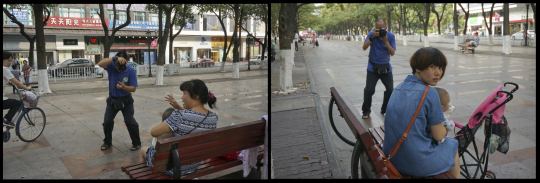
“I started this idea on my first trip to China, four years ago. I was thinking, Wow, what if my family never left? In Beijing, I saw these young kids, security guards, standing motionless. Skinny kids in oversized uniforms. I thought, That’s an interesting photograph. What if I did that? That was the first image in my head, being a security guard. Then to rationalize how I could have been this person: This person was in the army. I was a senior in high school when the U.S. abolished the draft. If they hadn’t abolished it I could have been in the army.”
What’s it like to enter these alternative lives?
“I can see that each experience has affected me differently. I’ve photographed tens of thousands of people over thirty years. And I’ve switched clothes only nine times so far, three times in Minnesota and the rest in Taishan, Guangzghou, Dongguan, and Lianzhou, all in Guangdong Province. All of these experiences were more personally affecting, in varied ways, than the act of taking any other photograph in my career. Some of them have been my most singular photographic and personal experiences. However, the diptych starts with my usual documentary process before I enter the photograph. But what happens during the process is unlike anything I’ve ever done, and I’m still trying to understand the meanings of the process as well as the resulting images.”
One story Wing tells is of a migrant worker sitting on the steps outside the Guangzhou Railway Station. Wing approached with his translator and started a conversation. After a couple hours, the man posed for a picture, and then exchanged clothes with Wing for the corresponding shot. However, the man was so ashamed of his soiled pants and shoes, which he said would fall apart if he took them off, that he only let Wing wear his shirt. Wing said, “It was the first time in my life I felt empathy for my father. Before, I knew what he did, but I couldn’t imagine what he did. Now I could imagine it. This guy’s still wandering China. He has no money. My father became successful. What if he hadn’t?”
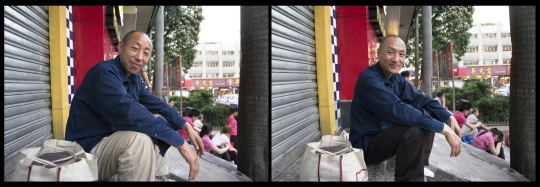
Hypothetical lives contrast among themselves and with the actual. I wanted to know if Wing had thought about including any photographs of his real life. It became clear he hadn’t decided yet.
“With my family it’s difficult … even Looking for Asian America [his third book], my sister had a problem with part of it. I’ve almost never photographed people I know for my projects. I don’t like to do it. I worry about using people… .”
It’s the difference between a hypothetical memoir and an explicit one. Normally when we think of photography and autobiography we think of the records of our lives and the burdens we put upon them to carry our memories. This is a taken-for-granted function of cameras: to document and, of course, to put in a positive light. Photography is nothing if not a point of view. The art of automatic photography lies mostly in choosing what the camera will be pointed at.
In sufficient quantity, these choices reveal something essential about the chooser. Dorothea Lange takes this line of thought to its logical conclusion when she says that every photograph is a self-portrait. These aren’t self-portraits as we’re used to them. What is preserved in the images is not the objective photographer but the subjective. But this subjectivity isn’t knowable in toto. Garry Winogrand, as John Szarkowski writes in Looking at Photographs, “made more than a third of a million exposures that he never even looked at.” If Winogrand never looked at them, were they actually his, or were they merely the stuff from which his photographs would have been composed—the material not yet the made thing?
The subjectivity we encounter as viewers is filtered. Photographs are edited at every stage of their production—in what they’re pointed at and when, in how they’re developed and cropped, and not least in the decision whether they are shown publicly, and if so in what context. In our era of myriad images more than ever, it is the editorial eye that makes a photographer. And that eye must see well. “A lot of how I photograph is about how good the photograph is. I still want it to be good, but the idea of what is good is different now. Say, the one with the red. Or the one in the restaurant. If I took those I wouldn’t have been happy with them. But in a way I did take them.”
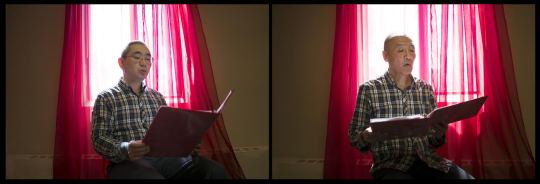
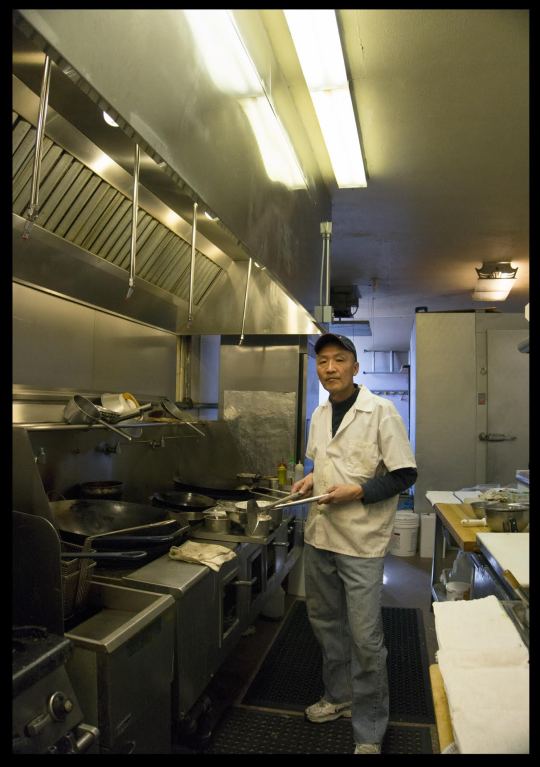
Not only is the concept of photographer troubled by Wing’s approach, so is the subject. When Wing enters into someone’s life he does not, for reasons mentioned earlier, become them—except that in a way he does. I wanted to know if the transformations made Wing’s identity feel unusually malleable, if he really feels himself becoming the other, as I gathered he did in the case of James.
“There’s definitely artifice. Everything I’m photographing is my subjective viewpoint. But it does create empathy for me. It’s going a step beyond taking someone’s photograph. You don’t want to overstate the empathy part but you don’t want to understate it either. When you wear someone’s clothes it does do something. It’s not just in the moment. It’s looking at it afterward. It does affect things, but in the end it’s still just a photograph.”
“Like the guy who didn’t want you to wear his pants,” I said. “What’s it like to look at the pictures of him? And did you get a sense of what it meant to him to be included in your project?”
“It meant a lot to him to be paid attention like that. He ended up saying, ‘If I get rich, I’m going to come to America and find you.’ It was one of the most memorable experiences of his life to be a part of this. Making connections is not easy in this culture, so when you make a connection like that … Before, the point for me was the photograph, now that’s shifted. The point for me is process, it’s what you tell people about it. If you just look at the picture you’ll think one thing. But if I tell you about the circumstances it makes you think differently. Everybody has this What if thing. You can’t experience another person’s life. And in this culture there’s little empathy. To create real empathy is different.”
Wing’s biography informs his work, but this is not what makes the work itself autobiographical—at least not in the memoiristic way I’m thinking of. But I didn’t know whether he would agree with this assessment of I Am the Other as memoir.
“It’s still a documentary, but it’s a different kind of documentary. In writing you have first-person, second-person, third person. This would be like all three.”
I need to pause here. This is a big idea. I understand Wing to mean that the third-person is the apparent objectivity of the camera and the first-person is the point of view of the photographer, but the second-person is more ambiguous. When the photographer becomes the subject it’s the first becoming the third. Where does the second enter in? I think of the viewer and of what Roland Barthes’s calls the Operator, the Spectator, and the Spectrum. The photograph, like all works of art, requires an audience to reach its completion: it’s a communicative act. How is this work its own audience, a communicative act with itself? And where does that leave the viewer? Phrased this way, it sounds to me like an insular project closed off from intersubjectivity. But solipsism doesn’t pertain to the experience of viewing I Am the Other. The problem might lie in my phrasing. Let me try a different tack.
Photographs are all about stories, but they do not tell them. Rather, they provoke storytelling in the viewer. And the satisfaction of a good photograph is in part the quality of the stories it enables the viewer to tell. It doesn’t matter what really occurred. So, again, what stories does I Am the Other tell, and how does it tell them to Wing as well as to the viewer? I think I’m onto something. Because we recognize Wing as the “photographer” and the subject and understand the project of his exploring other lives, the story he tells himself—his “second-person”—is the same story we tell ourselves: the stories of our possible alternative selves. What’s unique, then, about the project is that Wing allows himself to join us in telling an interpretive story of the photographs. Wing isn’t excluding us; he’s communing with us.
After our conversation, I went home to watch the documentary Nine Months in America, which accompanied Looking for Asian America. The Wing I saw on screen was a distinctly 1990s version of the man I know. Instead of the shaved head I’m familiar with, his hair was buzzed about half an inch. His sleek and fashionable wardrobe was replaced by baggy jeans, fleece vests, and clunky sneakers. Equally surprising, the Americans Wing and his then-wife Tara talk with in the film are uncommonly articulate. Another reminder from Wing how much we can learn when we get out of our private ways of seeing the world.
In a motel in Coos Bay, Oregon, an old black-and-white movie comes on the TV. Someone photographs the corner of the room where the TV is mounted on the wall. On screen, a young girl looks into the eyes of an adult whose hand holds her chin. In the motel room, a woman looks on, her reflection is captured in the mirror. It matters that the girl is Chinese, the woman is white, the photographer is Wing, and the context is Looking for Asian America; it matters that “Hundreds of Chinese were in the movie [The Keys of the Kingdom], but only one had a speaking part—played, of course, by a white guy.”
In her essay in Looking for Asian America, Anita Gonzalez writes, “Wing prompts us to consider the limitations of our own frames of reference.” One issue I feel like I’ve been skirting in the discussion of the relationship between self-portraiture/memoir and documentary photography/reporting is the degree to which I feel like I’m using Wing (and the other subjects in this series) to get the essays I want. They are, after all, mine. And yet they would not exist without others. Wing talks about carrying the guilt of exploitation, but not indulging it, so as not to let it interfere with the work. In writing this essay I’ve come to think of photography and memoir as two ways of studying time: photography through a window, memoir through a mirror.
Therefore guilt is inescapable. I can’t look away. While not explicitly memoir, the text becomes a kind of memoir insofar as a meditation on self-reflection reflects this self’s recurring meditations and, essayistically speaking, dramatizes the person behind them. To invoke the analogy, all photography is self-portraiture. Or to say in in the native language: all criticism is autobiography.
One of the shames of writing, for me, is that once I’ve published something it means I will go on saying it in writing long after I’ve come to prefer to have never said it at all. A photo, similarly, denies its subject the dignity of fading away. A photo is worse, even. With some regularity, I encounter things I’ve written that no amount of effort can make feel like mine. They belong to some other Scott F. Parker who no longer exists and I can’t remember knowing. In this, the linguistic self is easier to dissociate than the visual. When I see a picture of my younger self I say that’s me as if we still are one. I am not my ideas or my expressions in the same way that I am my image. Wing writes, about photographing in churches: “They want my soul. I want their pictures. It’s a fair exchange.”
I can’t look away from the guilt of using people to say what I want them to say. I’m constitutionally unable. But by putting the guilt under the light of attention and fixing it there in ink, I can try at least to turn what would be exploitation into honest collaboration.
In a follow-up, I tried to turn the tables on Wing and ask him what he would write if someone handed him a blank chalkboard. He said: “I’ve photographed thousands of strangers but am not close to many people.” He said this to me before a doubles match. After tennis, the four of us went out for drinks. At the bar, he met and recruited an old acquaintance to add to our pool of players. Before the evening ended, we made plans for basketball on Thursday, dinner with our partners Friday, and tennis again the following Sunday. I would never think that Wing doesn’t feel close to many people. But, as Wing reminds me, you can’t ever experience someone else’s life. All you can do is try to connect in whatever way is available to you. I am not the other, but I can be his friend.
Volume 1: Human Contact with Patricia Weaver Francisco
Volume 2: A Tremendous Sense of Purpose with Kao Kalia Yang.




